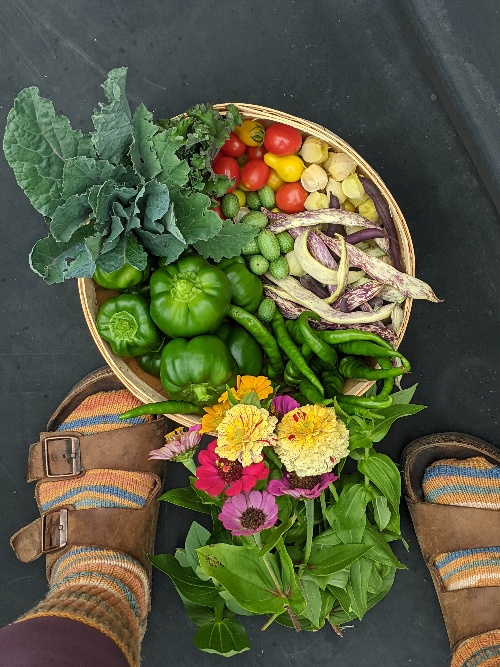
Christmas cactus (Schlumbergera spp.) is a popular old-fashioned houseplant. But despite their popularity, they still retain a bit of mystery. When do you repot them? How do you get the silly things to bloom? Why do they outlast other houseplants by decades?
While I can answer all of those questions for you, the one we’re going to focus on here is repotting.
Once you’ve repotted your Christmas cactus you might want to check out common reasons why it isn’t blooming and our extensive care guide.
Unlike what we think of when we picture traditional cacti, this plant thrives in humid, tropical environments. It requires special care, including proper repotting, to ensure they hit that decades-long lifetime achievement.
While Christmas cactuses need to be repotted far less frequently compared to other plants, knowing how and when to do it is crucial for continued blooming and health. So, let’s get right to it, shall we?
Knowing When to Repot a Christmas Cactus
Knowing when your Christmas cactus needs to be repotted is probably the most important aspect of this common houseplant task, as it’s different from other plants.
Christmas cactuses prefer to be quite snug in their pots, so being a little rootbound is a good thing. This is a common reason why your Christmas cactus might now be blooming; it might not be snug in its pot yet. On the other hand, if your Christmas cactus was blooming every year and has suddenly stopped, it might be too snug and is ready to be potted up so it will bloom again.
In general, if it’s been more than three years since you’ve repotted your Christmas cactus, it’s time for a soil refresh and either a bigger pot or a root trim for the same pot.
Best Time of Year to Repot a Christmas Cactus

The best time to repot a Christmas cactus is in late winter or early spring, in that dormant period when it’s finished blooming and before it starts its annual growth cycle. Repotting during this period gives your plant plenty of time to recover and grow new roots before it’s time to set buds.
You shouldn’t repot when the plant is actively flowering, as it can cause bud drop and stress the plant.

Choosing the Right Pot and Soil
Selecting the Right Pot
It’s important to pick the correct size pot for your Christmas cactus, as this can play a big role in whether or not your plant will bloom. Keep in mind these factors when choosing a pot:
- Size: Select a pot that is only one size larger than the current one. Remember, these plants like to be root-bound. Moving up to a pot that’s too large means it will take longer for the plant’s roots to be snug again. Likewise, more potting soil with a smaller root system can lead to root rot if you’re not careful. Most of the time I prefer to trim the roots of my Christmas cactus and repot it in the same pot.
- Material: I prefer ceramic or terracotta pots and avoid plastic pots, especially for Christmas cactus. Most ceramic pots are unglazed on the inside, making them porous, which helps control how much moisture is in the soil. Terracotta pots are even better at this but can dry out much faster. I don’t like plastic pots, even with a drainage hole. Because plastic isn’t porous, it can trap moisture in the soil for much longer than a ceramic pot. If you choose to use a plastic pot, you’ll need to pay attention to how much and how frequently you water.
- Drainage: The pot must have a drainage hole. This is the golden rule no matter what plant you’re repotting. Christmas cactuses are especially prone to root rot, so never use a pot without drainage.
Choosing the Right Soil
Holiday cactuses – Christmas cactus, Thanksgiving cactus and Easter cactus – are epiphytes, meaning they grow in the crooks of trees and crevices of rocks, using their roots to hold tight to the organic debris that collects in those cracks and crevices. With that in mind, it’s easy to see that traditional all-purpose potting soil is going to be much too heavy for these scrappy little plants.
These plants do best with a mix that’s lightweight and well-aerated. I highly recommend looking for a potting mix that’s blended specifically for epiphytes or aroids, such as this one.
DIYers can also mix up their own aroid potting mix.
- 2 parts potting soil
- 1 part perlite or sand (for aeration)
- 1 part coco coir (to retain moisture)
- Optional: A handful of compost or worm castings for added nutrients
Now that we’ve got your pot and potting mix squared away let’s repot a Christmas cactus.
Step-by-Step Guide to Repotting a Christmas Cactus
Gather Your Supplies
Before starting, make sure you have the following:
- A pot with a drainage hole
- Extra pot or bowl to hold the cactus
- Epiphyte or aroid potting mix
- Gloves (optional)
- Pruning shears or scissors
- A butter knife or trowel
- A watering can
- Something to protect your work surface
- Mycorrhizae (optional, but highly recommended, this is the brand I use)
Remove the Cactus from Its Old Pot

If the soil is dry, I suggest watering it and letting the plant sit for about fifteen minutes. It’s much easier to remove a plant with damp soil than dry.
If you’re working with an especially large Christmas cactus, it’s a good idea to have an extra empty, tall pot on hand to put the Christmas cactus in after you remove it. This will support the cactus while you prep the new pot, clean the root ball, etc.
You’re going to break a few segments. Just accept that fact now. It’s nearly impossible to repot a holiday cactus without breaking a few segments. Go slow and be careful, and you’ll minimize damage.
Use a butter knife or small garden trowel (depending on the size of the plant) to loosen the plant from the sides of the pot before removing it. Grasp the plant at the base and try to avoid tugging on the stems, as you can break them.

Inspect the Roots
Once the plant is out of the pot, examine the roots for signs of rot, disease, or overcrowding. Healthy roots should be firm and white. If you notice any mushy, brown, or black roots, trim them with sterilized pruning shears.
Loosen the Root Ball
Gently shake off excess soil and untangle any circling roots. This encourages the roots to spread out and establish more easily in the new soil. If you plan on repotting into the same pot or the same size pot, trim the roots to fit. If you’re using the same pot, clean it well before repotting your plant.
Place the plant aside in the extra pot/bowl.
Prepare the New Pot
Before you put soil in, you can place a bit of screen over the drainage hole to prevent the potting mix from washing out. Do not place rocks in the bottom of the pot.
Place a layer of fresh soil at the bottom of the new pot. This provides a foundation for the roots and ensures good drainage. Continue adding potting mix until the cactus sits roughly one inch below the lip of the pot.

Sprinkle mycorrhizae in the planting hole according to the package directions.
Replant the Christmas Cactus

Position the cactus in the center of the pot, fill in around the roots with the fresh soil mix, and lightly press it down as you go. Do not compact the soil too much, as this can reduce aeration. You want the plant to sit about one inch below the lip of the pot when you’re finished.
Give Your Plant a Warm, Gentle Shower

Once the Christmas cactus has been repotted, I put the whole thing in my shower and gently rinse off the plant using a light, warm mist. I lightly water it as well (very lightly) and then leave the plant to drain and dry off for a couple of hours. This initial watering helps the potting mix to settle back in around the roots and activate the mycorrhizae.
Post Repotting Christmas Cactus Care

Your plant will need to readjust and heal for a few weeks after it’s been potted. Keep it somewhere it will receive bright indirect light and high humidity. After the initial shower, don’t water it again until the top couple of inches of potting mix are dry.
Now is a good time to prune the plant, especially if you have trimmed off portions of the roots. We’ve got a complete guide to pruning your Christmas cactus here.

Give the plant around 3-4 weeks to bounce back and for the roots to heal before you resume fertilizing.
Within a month, your plant will be acclimated to its new home and should start putting out new growth. Continue to care for your plant, ensuring it gets lots of bright, indirect light, the proper fertilizer and water, and you’ll have a healthy, blooming Christmas cactus for decades to come.
Read Next:

Get the famous Rural Sprout newsletter delivered to your inbox.
Including Sunday musings from our editor, Tracey, as well as “What’s Up Wednesday” our roundup of what’s in season and new article updates and alerts.


